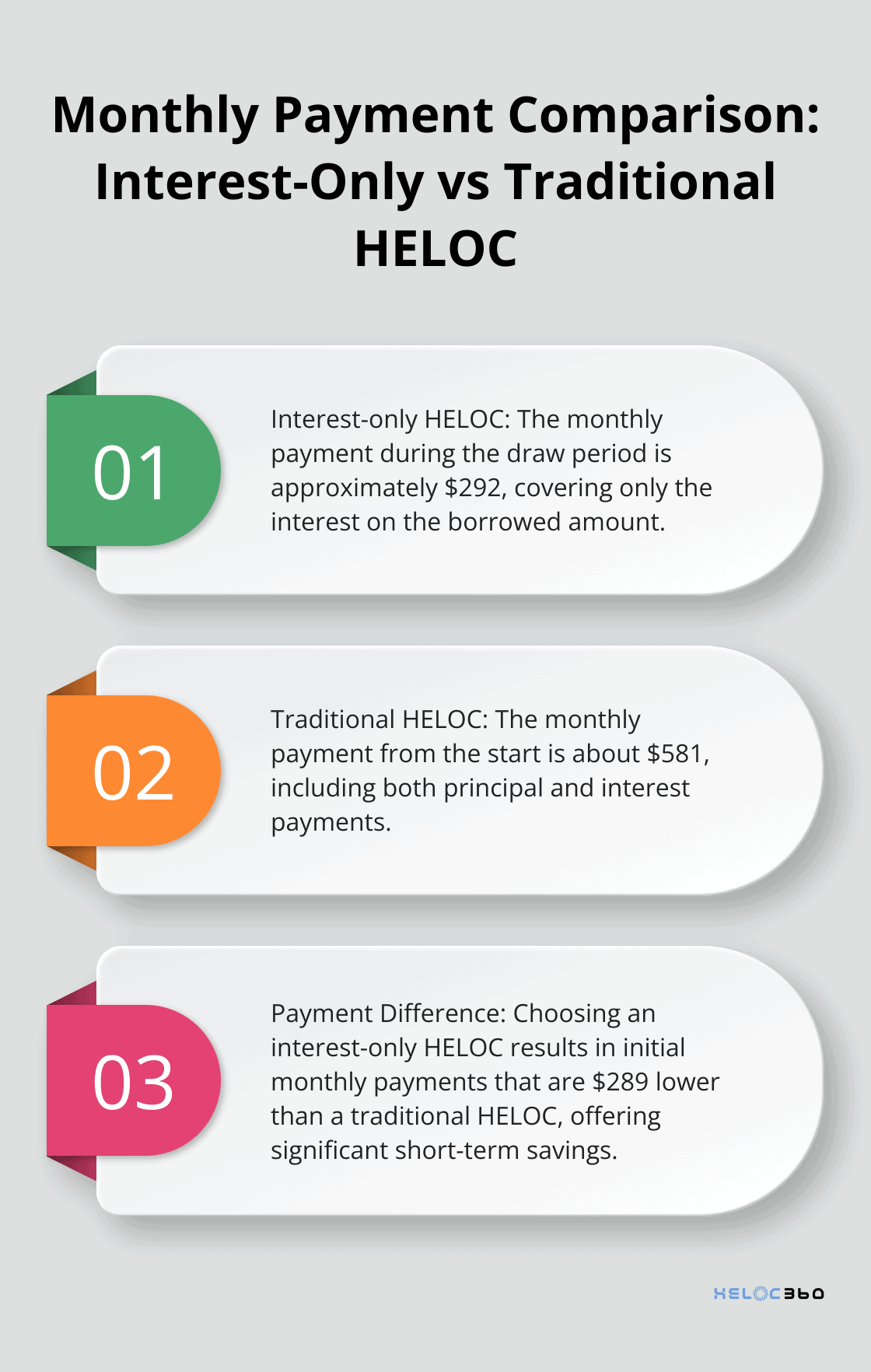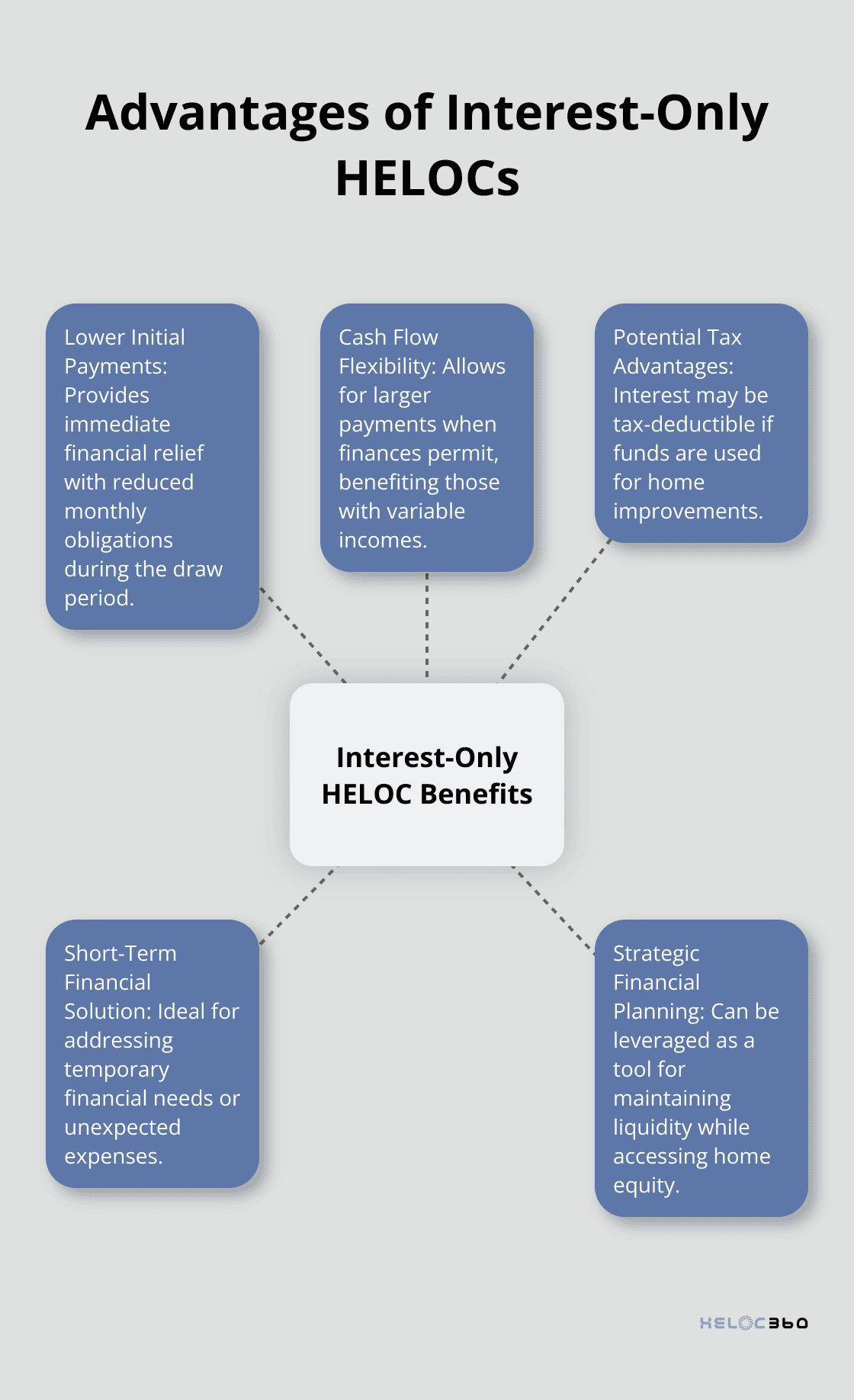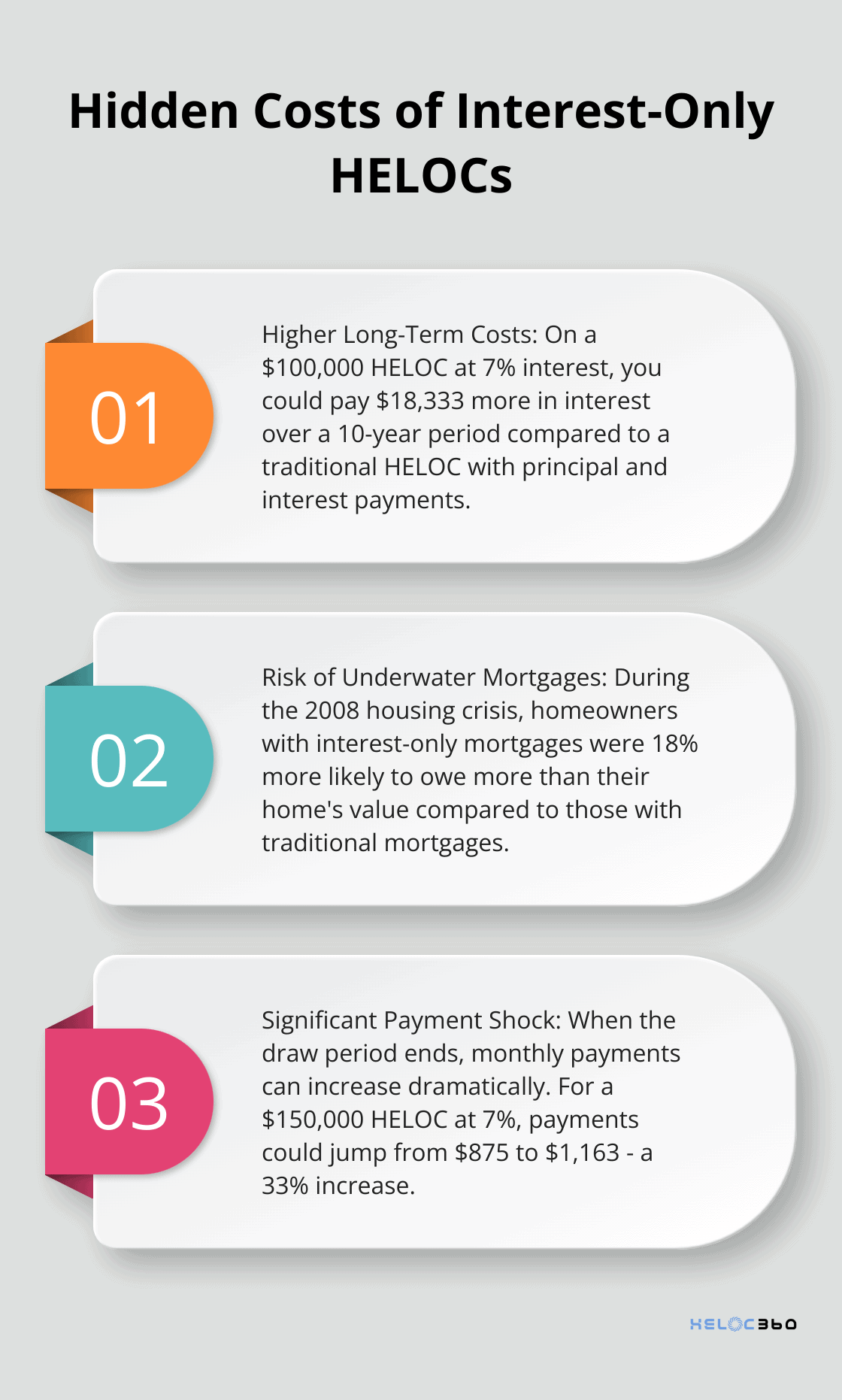Are you considering a HELOC with interest-only payments? This unique financial product can offer lower initial monthly payments and greater flexibility, but it’s not without risks.
At HELOC360, we’ve seen how interest-only HELOCs can be a powerful tool for some homeowners, while presenting challenges for others.
Let’s explore the ins and outs of this option to help you decide if it’s the right choice for your financial situation.
What Is an Interest-Only HELOC?
The Basics of Interest-Only HELOCs
An interest-only HELOC is a type of credit that lets you borrow funds against your equity and pay only interest during a set period. This type of loan provides a line of credit secured by your home’s equity. During the draw period (typically 10 years), you pay only interest on the borrowed amount. This results in lower monthly payments compared to traditional HELOCs where you pay both principal and interest from the start.
For instance, if you borrow $50,000 at a 7% interest rate, your monthly payment would be about $292 during the interest-only period. This is significantly less than the $581 you’d pay on a traditional HELOC with principal and interest payments.

How Interest-Only Payments Work
Interest-only payments don’t reduce the principal balance of your loan. Instead, they cover only the cost of borrowing the money. This can benefit those who need short-term financial flexibility or expect their income to increase in the future.
It’s important to note that once the draw period ends, you enter the repayment period. At this point, your payments increase as you start paying back both principal and interest. This can lead to a significant jump in your monthly obligations.
Interest-Only vs. Traditional HELOCs
While both types of HELOCs allow you to borrow against your home equity, they differ in their payment structure and long-term costs.
Traditional HELOCs require you to pay both principal and interest from the start. This means higher initial payments but a faster reduction of your loan balance. You’ll also pay less in total interest over the life of the loan.
Interest-only HELOCs offer lower initial payments but can result in higher overall costs. Research has shown that interest-only mortgages can have different repayment obligations compared to traditional loans.
Who Benefits from Interest-Only HELOCs?
Interest-only HELOCs can particularly benefit homeowners who need temporary financial flexibility or those who are confident in their ability to manage larger payments in the future. They can be useful for:
- Homeowners expecting a significant increase in income
- Those planning to sell their home before the draw period ends
- Individuals needing short-term funds for investments or business opportunities
However, it’s essential to carefully consider your long-term financial goals and ability to repay before choosing this option. The lower initial payments can be enticing, but the potential for higher overall costs (and the risk of payment shock) should not be overlooked.
As we move forward, let’s explore the specific advantages that interest-only HELOCs can offer to homeowners. These benefits might help you determine if this financial tool aligns with your unique situation and goals.
Why Interest-Only HELOCs Can Be Advantageous
Lower Initial Payments for Immediate Financial Relief
Interest-only HELOCs offer a significant advantage through lower initial monthly payments. This provides immediate financial relief, especially for homeowners who face temporary cash flow challenges. For example, if you borrow $100,000 at a 7% interest rate, your monthly payment during the interest-only period would be about $583. In contrast, a traditional HELOC with principal and interest payments could cost around $1,161 per month. This difference of $578 can be substantial for many households.
Maximizing Cash Flow Flexibility
Interest-only HELOCs offer unparalleled flexibility in managing your cash flow. You have the freedom to make larger payments when your finances allow, potentially paying down the principal faster. During leaner months, you can stick to the minimum interest-only payment. This flexibility benefits self-employed individuals or those with variable incomes. A study by the Federal Reserve Bank of New York found that self-employed individuals more often use alternative financing options like HELOCs due to their income variability.

Potential Tax Advantages
While tax laws can change, interest paid on home equity debt may be tax-deductible if the funds are used to buy, build, or substantially improve the home that secures the loan. This potential tax benefit can make interest-only HELOCs an even more attractive option for some homeowners. However, it’s important to consult with a tax professional to understand how this applies to your specific situation.
Useful for Short-Term Financial Needs
Interest-only HELOCs can be particularly beneficial for addressing short-term financial needs. Whether you’re funding a home renovation project, covering unexpected medical expenses, or investing in a business opportunity, the lower initial payments can provide the financial breathing room you need. This flexibility allows you to access funds when you need them most, without the immediate burden of principal repayment.
Strategic Financial Planning Tool
For savvy homeowners, an interest-only HELOC can serve as a strategic financial planning tool. It allows you to leverage your home equity while maintaining liquidity for other investments or financial goals. This can be especially useful if you anticipate a significant increase in income or plan to sell your home before the draw period ends.
As we explore these advantages, it’s important to also consider the potential drawbacks of interest-only HELOCs. Let’s examine some of the risks and challenges associated with this financial product in the next section.
The Hidden Costs of Interest-Only HELOCs
Home equity loans give you a lump sum to pay back over a set period with fixed payments, while a HELOC works more like a credit card. Let’s examine the potential pitfalls of these financial products.
Long-Term Financial Impact
Interest-only HELOCs often result in higher overall costs. On a $100,000 HELOC with a 7% interest rate, you’ll pay about $58,333 in interest over a 10-year draw period if you make only interest payments. In contrast, if you make principal and interest payments from the start, you’ll pay approximately $40,000 in interest over the same period. This $18,333 difference (a substantial amount) could fund other financial goals.
The Risk of Underwater Mortgages
Interest-only HELOCs can put you in a situation where you owe more on your home than it’s worth, especially in a declining real estate market. A study by CoreLogic found that during the 2008 housing crisis, homeowners with interest-only mortgages were 18% more likely to be underwater compared to those with traditional mortgages. This risk is particularly concerning for homeowners in areas with volatile property values.
Payment Shock and Financial Strain
When the draw period ends, many homeowners experience significant payment shock. For example, if you’ve borrowed $150,000 on an interest-only HELOC at 7%, your monthly payment during the 10-year draw period would be about $875. However, when you enter the 20-year repayment period, your monthly payment could jump to around $1,163 – a 33% increase. This sudden rise in payments can strain household budgets, potentially leading to financial distress or even default.

Home Equity Depletion
Interest-only payments don’t build equity in your home. This means you’re not increasing your ownership stake over time. In fact, if property values decline, you could find yourself with less equity than when you started. This situation can limit your financial options in the future, especially if you need to sell your home or refinance.
Variable Interest Rates
Most interest-only HELOCs come with variable interest rates. While rates might start low, they can increase over time, potentially making your payments unaffordable. HELOC rates are variable and tied to the Federal Reserve’s federal funds target rate. This unpredictability can make long-term financial planning challenging.
Final Thoughts
Interest-only HELOCs provide flexibility and lower initial payments, but they come with significant risks and potential long-term costs. Homeowners must carefully evaluate their financial situation, future income prospects, and long-term goals before choosing this option. The lower monthly payments during the draw period can be attractive, especially for those facing temporary financial challenges or expecting future income increases.
Financial advisors play a vital role when considering an interest-only HELOC. These professionals offer personalized advice based on your specific financial situation and help you understand the full implications of this borrowing option. They can also assist in creating a comprehensive financial plan that accounts for the potential risks and benefits of an interest-only HELOC.
We at HELOC360 offer expert guidance and tailored solutions for homeowners exploring their home equity options. Our platform helps homeowners understand their options, connect with suitable lenders, and make informed decisions about leveraging their home equity. HELOC360 empowers homeowners with the knowledge and tools they need to make the most of their home’s value while minimizing risks (including HELOC interest-only options).
Our advise is based on experience in the mortgage industry and we are dedicated to helping you achieve your goal of owning a home. We may receive compensation from partner banks when you view mortgage rates listed on our website.
